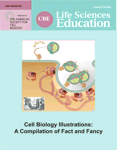Using Affinity Chromatography to Investigate Novel Protein–Protein Interactions in an Undergraduate Cell and Molecular Biology Lab Course
Abstract
Inquiry-driven lab exercises require students to think carefully about a question, carry out an investigation of that question, and critically analyze the results of their investigation. Here, we describe the implementation and assessment of an inquiry-based laboratory exercise in which students obtain and analyze novel data that contribute to our understanding of macromolecular trafficking between the nucleus and cytoplasm in eukaryotic cells. Although many of the proteins involved in nucleocytoplasmic transport are known, the physical interactions between some of these polypeptides remain uncharacterized. In this cell and molecular biology lab exercise, students investigate novel protein–protein interactions between factors involved in nuclear RNA export. Using recombinant protein expression, protein extraction, affinity chromatography, SDS-polyacrylamide gel electrophoresis, and Western blotting, undergraduates in a sophomore-level lab course identified a previously unreported association between the soluble mRNA transport factor Mex67 and the C-terminal region of the yeast nuclear pore complex protein Nup1. This exercise immersed students in the process of investigative science, from proposing and performing experiments through analyzing data and reporting outcomes. On completion of this investigative lab sequence, students reported enhanced understanding of the scientific process, increased proficiency with cellular and molecular methods and content, greater understanding of data analysis and the importance of appropriate controls, an enhanced ability to communicate science effectively, and an increased enthusiasm for scientific research and for the lab component of the course. The modular nature of this exercise and its focus on asking novel questions about protein–protein interactions make it easily transferable to undergraduate lab courses performed in a wide variety of contexts.



